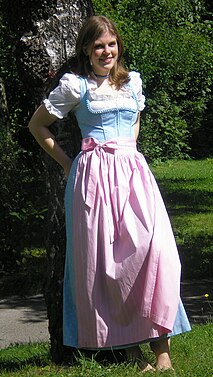 W
WThe fashion known as Altdeutsche Tracht, "old German" dress or costume, became popular in Germany between 1813 and 1815, during the time of what is in German historiography known as the Befreiungskriege, the "liberation wars", the last years of the Napoleonic Wars. It was an expression of anti-French German national sentiment and met with great approval among women and men of various social strata. The new fashion was intended as a demonstration of resistance against the "French fashion foolishness", as it was described.
 W
WA Bollenhut is a formal headdress with distinctive woolen pompoms worn since c.1750 by Protestant women as part of their folk costume or Tracht in the three adjoining Black Forest villages of Gutach, Kirnbach and Hornberg-Reichenbach. The picturesque-looking red Bollenhut has become a symbol of the Black Forest as a whole, despite its rather local origins. The red pom-poms and white brim of the Bollenhut also is said to have inspired the top layer of the Black Forest Cake.
 W
WA dirndl (German: [ˈdɪʁndl̩] , is the name of a feminine dress which originated in German-speaking areas of the Alps. It is traditionally worn by women and girls in southern Germany, Austria, Liechtenstein, Switzerland and Alpine regions of Italy. A dirndl consists of a close-fitting bodice featuring a low neckline, a blouse worn under the bodice, a wide high-waisted skirt and an apron.
 W
WGermany is a leading country in the fashion industry, along with France, Italy, Spain, the United States, the United Kingdom and Japan. German fashion is known for its elegant lines, unconventional young designs, and manufacturers of sports and outdoor clothing.
 W
WThe Gamsbart is a tuft of hair traditionally worn as a decoration on trachten-hats in the alpine regions of Austria and Bavaria.
 W
WLederhosen are short or knee-length leather breeches that are worn as traditional garments in some regions of German-speaking countries. The longer ones are generally called Bundhosen or Kniebundhosen. Once common workwear across Central Europe, these clothes—or Tracht—are particularly associated with Bavaria and the Tyrol region.
 W
WA loden cape is an overcoat of Tyrolean origin, made of a thick, water-resistant woolen material with a short pile known as loden cloth, first produced by peasants in Austria. This fabric is derived from the coarse, oily wool of mountain sheep and has a traditional earthy green colour. The name is derived from Middle High German "lode" or from Old High German "lodo", meaning "coarse cloth". It is a cloth of traditional Tracht worn in both Austrian and German Tyrol.
 W
WTracht refers to traditional garments in German-speaking countries and regions. Although the word is most often associated with Bavarian, Austrian, South Tyrolian and Trentino garments, including lederhosen and dirndls, many other German-speaking peoples have them, as did the former Danube Swabian populations of Central Europe.
 W
WThe Tyrolean hat, also Bavarian hat or Alpine hat, is a type of headwear that originally came from the Tyrol in the Alps, in what is now part of Austria, Germany, Italy and Switzerland.